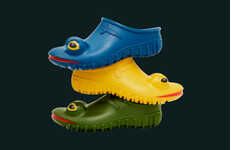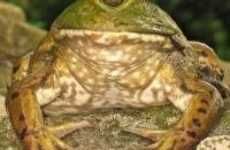
Toads Used as Fertilizer
A cane toad the size of a small dog has been captured in Australia. Cane Toads are considered an environmental hazard in Australia since been introduced in 1930's, and thought responsible for killing countless numbers of animals. The massive toad was found on a pond raid in Darwin, and is the size of a football weighing in at a massive 2 pounds. What was even more unusual is that the largest toads are normally female but this was a "rampant male."
Known as the Toad Buster project, Frogwatch, conducts raids on local water holes, blinding the toads with bright lights then scooping them up. They are then killed with carbon dioxide gas and stockpiled in a large freezer. When enough have been gathered the dead toads are put through a detoxifying process that is said to turn them into brilliant fertilizer.
Lets just be thankful you cant eat them!
Known as the Toad Buster project, Frogwatch, conducts raids on local water holes, blinding the toads with bright lights then scooping them up. They are then killed with carbon dioxide gas and stockpiled in a large freezer. When enough have been gathered the dead toads are put through a detoxifying process that is said to turn them into brilliant fertilizer.
Lets just be thankful you cant eat them!
Trend Themes
1. Toxic Animal Removal - There is a disruptive innovation opportunity in developing advanced methods to safely and efficiently remove toxic animals like cane toads from the environment.
2. Sustainable Fertilizer Production - The use of detoxified cane toads as fertilizer presents a disruptive innovation opportunity for the agricultural industry to develop more sustainable and eco-friendly methods of fertilizer production.
3. Wildlife Conservation Technology - Developing innovative technologies to monitor and control the populations of invasive species like cane toads can lead to disruptive solutions in wildlife conservation.
Industry Implications
1. Environmental Services - The environmental services industry can explore disruptive innovation opportunities in toxic animal removal and the development of sustainable practices for wildlife conservation.
2. Agriculture - The agriculture industry has the potential to benefit from disruptive innovation in sustainable fertilizer production using detoxified cane toads.
3. Ecological Technology - Ecological technology companies can focus on disruptive innovation in developing advanced tools and technologies for wildlife conservation and invasive species control.
2.3
Score
Popularity
Activity
Freshness























